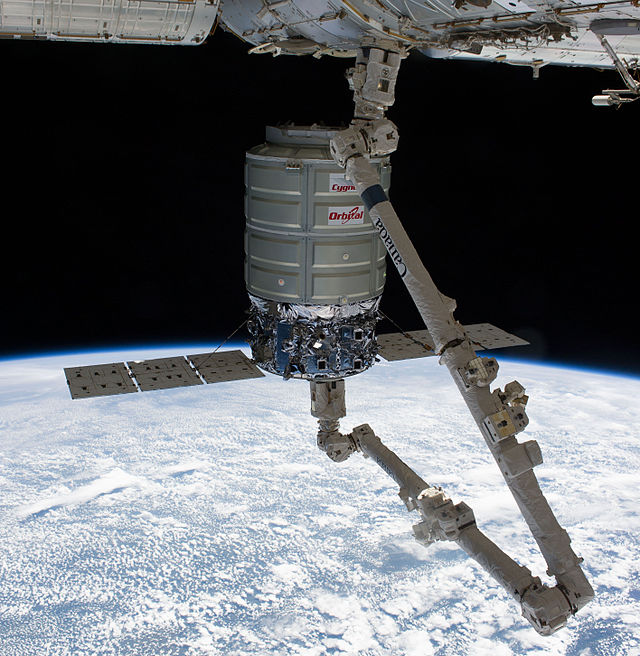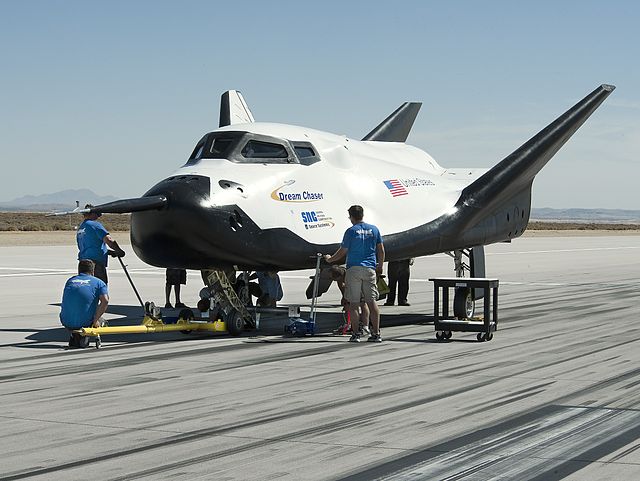Commercial Resupply Services
NASA program for delivery of cargo to the ISS From Wikipedia, the free encyclopedia
Commercial Resupply Services (CRS) are a series of flights awarded by NASA for the delivery of cargo and supplies to the International Space Station (ISS) on commercially operated spacecraft.[1]
| Commercial Resupply Services | |
|---|---|
| Type of project | Aerospace |
| Owner | NASA |
| Country | United States |
| Established | 2008 |
| Status | Active |
| Website | www |
The first phase of CRS contracts (CRS-1) were signed in 2008 and awarded $1.6 billion to SpaceX for twelve Dragon 1 and $1.9 billion to Orbital Sciences[note 1] for eight Cygnus flights, covering deliveries to 2016. The first operational resupply missions were flown by SpaceX in 2012 (CRS SpX-1)[2] and Orbital in 2014 (CRS Orb-1).[3] In 2015, NASA extended CRS-1 to twenty flights for SpaceX and twelve flights for Orbital ATK.[note 1][4][5]
A second phase of contracts (CRS-2) was solicited in 2014. CRS-2 contracts were awarded in January 2016 to Orbital ATK's continued use of Cygnus, Sierra Nevada Corporation's new Dream Chaser, and SpaceX's new Dragon 2, for cargo transport flights beginning in 2019 and expected to last through 2024.
Phase 1 contract awards and demonstration flights
Summarize
Perspective
NASA has been directed to pursue commercial spaceflight options since at least 1984, with the Commercial Space Launch Act of 1984 and Launch Services Purchase Act of 1990. By the 2000s funding was authorized for the Commercial Orbital Transportation Services program, followed by the Commercial Crew Development program.
On 23 December 2008, NASA announced the initial awarding of cargo contracts - twelve flights to SpaceX and eight flights to Orbital Sciences Corporation.[6] PlanetSpace, which was not selected, submitted a protest to the Government Accountability Office.[7] On 22 April 2009, the GAO publicly released its decision to deny the protest, allowing the program to continue.[8]
The Antares and Falcon 9 launch vehicles and Cygnus and Dragon cargo spacecraft were developed using Space Act Agreements under NASA's Commercial Orbital Transportation Services (COTS) program.[9]
The first flight contracted by NASA, COTS Demo Flight 1, took place on 8 December 2010, demonstrating a Dragon capsule's ability to remain in orbit, receive and respond to ground commands, and communicate with NASA's Tracking and Data Relay Satellite System. On 15 August 2011, SpaceX announced that NASA had combined the objectives of the COTS Demo Flight 2 and following Flight 3 into a single mission.[10][11] The rescoped COTS Demo Flight 2 successfully launched on 22 May 2012, delivering cargo to the ISS. The spacecraft reentered on 31 May, landed in the Pacific Ocean, and was recovered, completed CRS certification requirements.[12][13]
Orbital Sciences first launched the Antares rocket from the Mid-Atlantic Regional Spaceport on 21 April 2013 with a test payload.[14] Orbital Sciences completed the Cygnus Orb-D1 demonstration flight on 29 September 2013, and the operational Cygnus CRS Orb-1 was launched 9 January 2014.[15][16][17][18]
Commercial Resupply Services phase 1
Summarize
Perspective
Transport flights began under Commercial Resupply Services phase 1 (CRS-1) in 2012:
Cargo Dragon flights

- CRS SpX-1: 8 October 2012[2][19]
- CRS SpX-2: 1 March 2013[20]
- CRS SpX-3: 18 April 2014[20]
- CRS SpX-4: 21 September 2014.[20]
- CRS SpX-5: 10 January 2015[21]
- CRS SpX-6: 14 April 2015
- CRS SpX-7: attempted on 28 June 2015. Launch failure 139 seconds after lift-off, IDA-1 destroyed. Investigation traced the accident to the failure of a strut inside the second stage's liquid-oxygen tank. NASA concluded that the most probable cause of the strut failure was a design error: instead of using a stainless-steel eye bolt made of aerospace-grade material, SpaceX chose an industrial-grade material without adequate screening and testing and overlooked the recommended safety margin.[22]
- CRS SpX-8: 8 April 2016
- CRS SpX-9: 18 July 2016
- CRS SpX-10: 19 February 2017
- CRS SpX-11: 3 June 2017
- CRS SpX-12: 14 August 2017
- CRS SpX-13: 15 December 2017[23]
- CRS SpX-14: 2 April 2018
- CRS SpX-15: 29 June 2018[24]
- CRS SpX-16: 5 December 2018[25][26][27]
- CRS SpX-17: 4 May 2019
- CRS SpX-18: 25 July 2019
- CRS SpX-19: 5 December 2019
- CRS SpX-20: 7 March 2020
Cygnus flights


- CRS Orb-1[note 2]: 9 January 2014
- CRS Orb-2: 13 July 2014
- CRS Orb-3: 28 October 2014 - launch failure, food and care packages for the crew, parts, experiments, and the Arkyd-3 Flight Test (Non-optical) Satellite from Planetary Resources lost.
Following the failure, the Antares rocket was upgraded to the 230 series which used newly built RD-181 first-stage engines to provide greater payload performance and increased reliability.[28] The next two spacecraft were launched on the Atlas V. With the switch to more powerful launch vehicles and the introduction of a larger Enhanced Cygnus, enabled Orbital ATK to cover their initial CRS contracted payload obligation by OA-7.[29][30]
- CRS OA-4[note 3]: 6 December 2015 - Atlas V, first Enhanced Cygnus[29]
- CRS OA-6: 23 March 2016 - Atlas V
- CRS OA-5: 17 October 2016 - Antares 230
- CRS OA-7: 18 April 2017 - Atlas V
During August 2015, Orbital ATK disclosed that they had received an extension of the resupply program for four extra missions. These flights enable NASA to cover ISS resupply needs until CRS-2 begins.[29]
CRS Phase 2 solicitation and requirements
Summarize
Perspective
NASA began a formal process to initiate Phase 2 of the Commercial Resupply Services, or CRS-2, in early 2014.[36] Later that year, an "Industry Day" was held in Houston, with seven high-level requirements disclosed to interested parties.[37]
Requirements
The contracts were expected to include a variety of requirements:[37]
- delivery of approximately 14,000 to 17,000 kg (31,000 to 37,000 lb) per year 55 to 70 m3 (1,900 to 2,500 cu ft) of pressurized cargo in four or five transport trips
- delivery of 24–30 powered lockers per year, requiring continuous power of up to 120 watts at 28 volts, cooling, and two-way communications
- delivery of approximately 1,500 to 4,000 kg (3,300 to 8,800 lb) per year of unpressurized cargo, consisting of 3 to 8 items, each item requiring continuous power of up to 250 watts at 28 volts, cooling, and two-way communications
- return/disposal of approximately 14,000 to 17,000 kg (31,000 to 37,000 lb) per year 55 to 70 m3 (1,900 to 2,500 cu ft) of pressurized cargo
- disposal of 1,500 to 4,000 kg (3,300 to 8,800 lb) per year of unpressurized cargo, consisting of 3 to 8 items
- various ground support services
Proposals
CRS-1 contractors Orbital Sciences[note 1] and SpaceX each submitted CRS-2 proposals, joined by Sierra Nevada, Boeing, and Lockheed Martin.[38]
SNC's proposal would use a cargo version of its Dream Chaser crew vehicle, the 'Dream Chaser Cargo System'. The proposed cargo Dream Chaser included an additional expendable cargo module for uplift and trash disposal. Downmass would only be provided via the Dream Chaser spaceplane itself.[38] Boeing's proposal likewise used a cargo version of its CST-100 crew vehicle.[39][40]
Lockheed Martin proposed a new cargo spacecraft called Jupiter, derived from the designs of the NASA's MAVEN and Juno spacecraft. It would have included a robotic arm based on Canadarm technology and a 4.4-meter (14 ft) diameter cargo transport module called Exoliner based on the Automated Transfer Vehicle, to be jointly developed with Thales Alenia Space.[40][41][42]
Awards
Three companies were awarded contracts on January 14, 2016.[43][37] Sierra Nevada Corporation's Dream Chaser, the SpaceX Dragon 2, and Orbital ATK[note 1] Cygnus were selected, each for a minimum of six launches.[43][44] The maximum potential value of all the contracts was indicated to be $14 billion, but the minimum value is considerably less. CRS-2 launches commenced in 2019 and will extend to at least 2024.
Three more CRS-2 missions for Dragon 2 covering up to CRS-29 were announced in December 2020.[45][46]
Commercial Resupply Services phase 2 - Awards and flights flown
Summarize
Perspective

When NASA issued the Commercial Resupply Services phase 2 (CRS-2) request for proposal (RFP) in September 2014, it received interest from five companies: Lockheed Martin, Boeing, Orbital ATK, Sierra Nevada, and SpaceX. NASA made a competitive range determination to remove Boeing and Lockheed Martin.
Orbital ATK (later purchased by Northrop Grumman), Sierra Nevada, and SpaceX were awarded CRS-2 contracts in January 2016 with initial task orders awarded in June 2016. Each of the three companies is guaranteed at least six cargo missions under the CRS-2 contract. As of December 2017, NASA had awarded $2.6 billion on three contracts with a combined, not-to-exceed value of $14 billion. NASA officials explained that selecting three companies rather than two for CRS-2 increases cargo capabilities and ensures more redundancy in the event of a contractor failure or schedule delay. The CRS-2 flights commenced in November 2019 with the launch of Cygnus NG-12 mission.[47]
Inside-cargo is typically transported to and from the space station in "the form factor of single Cargo Transfer Bag Equivalent (CTBE) [which is the] unit for size of bag used to transport cargo from visiting vehicles,[48] such as SpaceX Dragon, Northrop Grumman Cygnus, or JAXA H-II Transfer Vehicle (HTV). The bags are sized at 48 cm × 41 cm × 23 cm (19 in × 16.25 in × 9 in) and limited in transport mass to 27 kg (60 lb) each.[48] CTBE units are also used to price, and charge, commercial users of US Orbital Segment stowage space.[49]
Cygnus flights

- CRS NG-12: 2 November 2019
- CRS NG-13: 15 February 2020
- CRS NG-14: 3 October 2020
- CRS NG-15: 20 February 2021
- CRS NG-16: 10 August 2021
- CRS NG-17: 19 February 2022
- CRS NG-18: 7 November 2022
- CRS NG-19: 2 August 2023
As a result Russia's invasion of Ukraine, Northrop Grumman was left with only two remaining Antares 230+ launch vehicles which were used for the CRS NG-18 and CRS NG-19 missions. Northrop Grumman acquired three flights from SpaceX with the Falcon 9 rocket while a replacement first stage and its engine are developed for its Antares 330 rocket.[50]
- CRS NG-20: 30 January 2024
- CRS NG-21: 4 August 2024
- CRS NG-22: TBD (indefinitely delayed after cargo module damaged during shipment)[51]
Northrop Grumman plans to launch further missions using the new Antares 300 series (Antares 330) rockets with booster stage and engines developed by Firefly Aerospace.[50][52] These missions are also slated to use a new enlarged "Mission B" variant of the Cygnus spacecraft.
Cargo Dragon flights
- CRS SpX-21: 6 December 2020
- CRS SpX-22: 3 June 2021
- CRS SpX-23: 29 August 2021
- CRS SpX-24: 21 December 2021
- CRS SpX-25: 15 July 2022
- CRS SpX-26: 26 November 2022
- CRS SpX-27: 14 March 2023
- CRS SpX-28: 5 June 2023
- CRS SpX-29: 10 November 2023
- CRS SpX-30: 21 March 2024
- CRS SpX-31: 5 November 2024
- CRS SpX-32: 21 April 2025 (planned)
- CRS SpX-33: August 2025 (planned)[54]
- CRS SpX-34: Early 2026 (planned)[53]
- CRS SpX-35: Late 2026 (planned)[53]
Cargo Dream Chaser flights
- SSC Demo-1: Q3 2025 (planned)
- CRS SSC-1 to CRS SSC-6: TBA
See also
- Cargo spacecraft
- Commercial Crew Development (CCDev) – development of crew vehicles
- Commercial Orbital Transportation Services
- Comparison of space station cargo vehicles
- Dream Chaser
- Cygnus (spacecraft)
- Crew Dragon
- Multi-Purpose Logistics Module (STS cargo container)
- Commercial Lunar Payload Services
Notes
- Orbital Sciences was awarded a CRS contract in 2008. In 2015, Orbital Sciences became Orbital ATK through a business merger. Orbital ATK was awarded a CRS-2 contract in 2016. In 2018, Orbital ATK was acquired by Northrop Grumman.
- Cygnus was owned and operated by Orbital Sciences for missions CRS Orb-1 to CRS Orb-3.
- Cygnus was owned and operated by Orbital ATK for missions CRS OA-4 to CRS OA-9E.
- Cygnus has been owned and operated by Northrop Grumman since mission NG-10.
References
External links
Wikiwand - on
Seamless Wikipedia browsing. On steroids.



